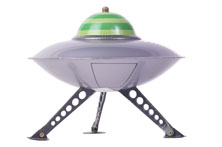Spanish science fiction: Spanish literature you’ve never heard of
I’m sure you’ve seen in your bookshop that Spanish authors cover many genres: historical, dark, satirical, romance, social… But science fiction as well?

Many literature critics think this genre is more of an English-speaking phenomenon than a Spanish one. But this isn’t actually the case: science fiction authors in Spain have always been around; in fact the Golden Book of Emperor Marco Aurelio, written by Antonio de Guevara in 1528, is quoted as a clear precedent that addressed the subject of a utopian society; the same could be said of the journey in the second part of Don Quijote in which the knight and Sancho Panza believe they are flying to the stars on the back of a wooden horse called Clavileño (Pegwood).
But for many, the truly Spanish version of science fiction begins with a strange book entitled Lunigrafia, written in 1855 by M. Krotse, a pseudonym for the Catalan lawyer Miguel Estorch y Siques. As well as describing society and “lunigraphic” customs, the author speculates on riding a cannon ball to the moon. Sound familiar? Yes, it’s the same mode of transportation that Jules Verne describes in his 1865 book From the Earth to the Moon.
Parts of "Lunigrafia" were criticized during its time, just like it still is today. But there is also that satirical part we Spaniards like just as much; although if we must speak about satirical science fiction, we have to quote Juan Perez Zuniga, who, in his 1905 story Six Days Outside the World, describes a journey to Venus…in a floating wardrobe and with ham as food for the astronauts!

For most bookworms, Spanish science fiction would reach its maturity with Jesus de Aragon y Soldado’s work, who would be nicknamed the Spanish Julio Verne, and whose biography we’ll publish in another article. His was extravagant and successful, although these days he is practically unknown to the general public.
Something more well known – although not by that much – is the work of Pascual Enguidanos, “La Saga de los Aznar”, which acts as the Spanish equivalent of American pulp space operas of the 1950s, 1960s and 1970s. Strangely, although the series had 54 titles and public success, it’s difficult to find any example of these sorts of novels today.
During the 1970s and 80s, the production of Spanish science fiction stories was consigned to specialized magazines and collector sets. Nevertheless, during the 1990s there was a resurgence, during which high quality books were published by authors like Cesar Mallorquí (La Mansion Dax), Eduardo Vaquerizo (Danza de Tinieblas), Javier Negrete (Senores del Olimpo)…and many more! We won’t tell you anymore because we want you to discover it for yourself. You’ll find fantastic authors, amazing worlds and a whole new genre to investigate!




